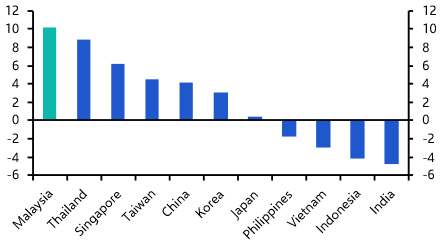25 years ago this month the Bank of England was granted operational independence by the then-Chancellor Gordon Brown. Uncomfortably for current members of the Monetary Policy Committee, the anniversary coincides with a new set of forecasts by the Bank’s staff showing that UK inflation is on track to hit 10% by the end of this year. This raises a broader question about whether the monetary policy framework that was put in place a quarter of a century ago is still fit for purpose.
This is not just a question for the UK. After all, every major advanced economy now uses some form of inflation-targeting regime administered by a central bank with operational independence from government. (See Table.) And every major advanced economy has experienced a surge in inflation to well above target rates over the past year.

At first sight, this would appear to suggest that the current approach to monetary management is fundamentally broken. But in truth the past year has been the exception rather than the rule. Since the Bank of England was granted operational independence UK inflation has averaged 2% – exactly in line with its target. It’s a similar story in other countries.
Admittedly, for most of this period all central banks have operated under extremely benign conditions: the integration of China into the world trading system has brought down goods inflation; labour reforms have diminished union power and made jobs markets more flexible; and technological advances have brought down the cost of capital goods.
Yet while central banks have undoubtedly had a helping hand, it’s also the case that, from the perspective of controlling inflation, the current policy regime has been an improvement on what came before. If central banks now succeed in bringing inflation back down to target – after this, the largest inflation shock in nearly 50 years – it will further strengthen the argument that inflation-targeting has been a success.
When the economic history of the pandemic is written, it will be difficult to justify why the Fed was still buying mortgage-backed securities at a time when US house prices were growing by almost 20% y/y.
With all that being said, there are still important policy lessons to be learnt from the surge in inflation over the past year.
The first is that we should recognise there are limits to the ability of monetary policy and central banks to control inflation outcomes. Yes, mistakes have been made and policy has been kept too loose. When the economic history of the pandemic is written, it will be difficult to justify why the Fed was still buying mortgage-backed securities at a time when US house prices were growing by almost 20% y/y.
But much of the rise in inflation has been driven by pandemic-related shifts in consumption patterns and a surge in global commodity prices. Viewed this way, it’s not obvious that tighter monetary policy would have produced a radically different inflation outcome.
Second, this paradoxically increases the importance of having a strong nominal anchor for policy. With headline inflation rates increasingly likely to be buffeted by factors outside of central banks’ control – from the effects of US-China decoupling to efforts to “green” economies – it’s critical that markets keep faith that central banks will ultimately return inflation to low but positive rates over the medium-term. Accordingly, it’s important that monetary policymakers focus on inflation and don’t get distracted by other goals. Above all else, this means reasserting the primacy of price stability mandates.
Finally, while the past year has exposed the limits of monetary policy, it has also revealed the power of fiscal policy. In particular, the strength of demand in the wake of the pandemic has been due primarily to the extraordinary amount of fiscal support that was provided by governments rather than by monetary accommodation. This has challenged the prevailing orthodoxy of the past thirty years, which held that the primary role for governments in economic policy was to run a tight fiscal ship. This view informed the shift to fiscal austerity following the global financial crisis, which in turn was a major contributor to the sluggishness of the subsequent recovery. The much faster recovery from the pandemic suggests there is a case for greater fiscal activism going forward.
All of this has significant implications for how policy frameworks should now evolve. The first point to emphasise is that central banks should focus squarely on maintaining price stability and financial stability. This does not preclude making changes to the inflation-targeting frameworks, for example by widening the target range or tweaking the target. But the primary objective should be to uphold price and financial stability. Other goals, from greening economies to ensuring affordable housing, while laudable, are best achieved using alternative policy levers.
More fundamentally, monetary and fiscal policy will have to work together more closely to achieve price and financial stability. The huge amount of fiscal support provided during the pandemic contributed to the subsequent surge in inflation, particularly in the US. But the current combination of continuing froth in some asset markets (especially housing) alongside a huge squeeze on real incomes now suggests that monetary policy is too loose and fiscal policy too tight in most advanced economies.
Getting the monetary-fiscal balance right will be key to the continuing success of inflation targeting in future. And it will need to remain successful: central bankers have enjoyed decades of relatively benign inflationary conditions – what is to come will be far more challenging.
In case you missed it:
- Capital Calls map out the market implications of our highest-level macro calls. Our latest refresh includes how we think aggressive central bank tightening will continue to weigh on risky assets and drive up the dollar.
- Our Emerging Europe Economist, Liam Peach, crunches the numbers on Russia’s ballooning trade surplus.
- Kieran Tompkins argues that earnings optimism may not bail out the US equity market.


